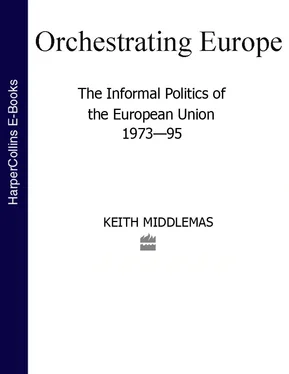Of this, Arthur Cockfield would remind them, in his foreword to his White Paper on establishing the internal market, three years later. At the time, it led to a modestly constituted Internal Market Council and the beginnings of a concerted plan by DG3, together with officials of the largest member states, whose outward face could be read in a host of Commission papers arguing this as the only way to recover competitiveness; 56and (since EMU was always a contingent matter) currency and monetary stability. Under the German Presidency the plan gathered momentum, 57and at Council level culminated in the ‘solemn declaration’ on EC Unity at Stuttgart 19 June 1983.
Soon afterwards, in September, once the drama over French restraints on the entry of Japanese VCRs had been resolved, the French government produced a memorandum Vers une espace industrielle Européenne. A Commission mandate of sorts now existed to prepare something more specific for the Athens Summit in December. But too much Council time was being consumed by the acerbic British budget question (from which the French government took advantage to delay Spanish accession, reform of the CAP and structural funds). The hostilities which had attended the messy EMS general revaluation in March had also not entirely disappeared. The European Parliament was dissipating its energies on dreams of European Union inspired by Stuttgart (which Thatcher regarded as itself an illusion 58and which Mauroy also condemned as eroding the national right of veto). Systemic reform depended that summer on three assumptions: that West Germany would not drop its opposition to increasing the Community’s revenue by 1 % on VAT until the reform process had actually started (even at the risk of the EC’s temporary bankruptcy), that the British would not shout too loudly, and that Greece would handle its first Presidency competently.
On these assumptions and inspired by Stuttgart, senior officials in the Commission such as Fernand Braun (DG3) and Paolo Cecchini, Maurice Carpentier, Peter Klein, and Riccardo Perissich, prepared something more dynamic and far-reaching than Commissioner Narjes’ long catalogue of directives-in-waiting since the mid–1970s (which was not actually published until mid–1984). They were able to capitalize on work done in some Departments of Industry, notably in Bonn, London and Paris and on the technical harmonization and the implications of Cassis de Dijon, so that by October, Narjes could outline ‘a more general common approach’ on mutual recognition, rather than total harmonization, to the Internal Market Council. Since Britain, France and Germany now had the clearest policies in this area, Cecchini invited top officials from the Economics Ministry in Bonn, the DTI, and the French Industry Ministry to meet him at the Chateau de Namur, 15–16 October, and here, under very informal Commission auspices, a text was agreed and immediately translated into the three languages. This was fed indirectly to the Steering Committee texts for Athens, as a prototype ‘declaration for the internal market’. 59It was lost of course, in the Athens debacle, illustrating both the powers and limits of sub rosa Commission work. But its substance emerged eventually in the EC resolution, 7 May 1985, which indicates the strength of such little-seen trends.
There had been no reason before Athens to think these preparations inadequate. Greek demands had already apparently been appeased with a careful devaluation of the drachma and a scheme of transitional financial support. Greece now took 16% of the regional development fund budget. No fewer than seven special Council meetings took place to sort out in advance the reforms of CAP and the structural funds, together with forms of EC-wide cooperation on the technological challenge to competitiveness, a balanced package involving increased revenue, better budgetary discipline, and prevention of future imbalances to meet the British criticisms. Such a comprehensive package might conceivably have been steered between the British Scylla and the French Charybdis.
Instead a combination of Greek inexperience in the Presidency, and Pasok’s factious demands for yet more cash support, together with Papandreou’s erratic chairmanship, shattered Summit conventions and these tenuous agreements. But it should be added that other heads of government also played disingenuous roles: 60with the French Presidency coming up, Greece was not to have the glory. Nevertheless the fiasco was so total that it proved impossible even to draft an agreed communiqué.
Confusion among member states did not necessarily imply total failure. Within six months, under the French Presidency, all these questions had been brought into line, largely by Mitterrand, now at his peak, yet ever conscious of the need for West German backing. France and Germany were finally able to meet even Britain’s demands. But the passage was hard despite the fact that Commission, Parliament and most member states were within reach of each other. After Mitterrand’s speech on federalism at Strasbourg in May 1984, and Lord Carrington’s swift riposte on the budget, it needed the spectre of EC bankruptcy in March and Mrs Thatcher’s refusal of the ‘best offer’, 61before ministers finally conceded guaranteed thresholds on CAP farm prices, in order to phase out slowly the onerous MCAs.
At the Fontainebleau Summit of 25–26 June (just after the European Parliament’s second direct election) the deadlock broke on the CAP and the budget reforms, together with Britain’s contributions. 62Germany, which was to pay most of the debit, won a special subvention for German farmers. ‘Own resources’ were increased to the necessary 1.4% on VAT revenues, leaving loose ends to be tied up in Dublin in December with a final cash subvention for Mediterranean agriculture and the acceptance of an – as yet unformulated – integrated Mediterranean programme.
That in turn removed the southern French farmers’ objection to Spanish accession. 63Spain’s and Portugal’s negotiations, so long delayed by pretexts, were rapidly concluded in March 1985 and the Treaty of Accession was signed in June, providing for entry on 1 January 1986. Meanwhile meetings with EFTA ministers saw the beginning of negotiations on the European Economic Area which, however difficult at times, began what was to be a steady enhancement of mutual economic relations over the next five years. The EC itself came closer to a standards policy, and simpler border formalities with the adoption of a single Community Customs document. France and Germany declared that they would abolish border checks, 64and set off on the road to what became the Schengen agreement.
But the impetus went further. The Council at Fontainebleau appointed two committees to examine the EC’s future: one chaired by James Dooge (an Irish senator) on institutional affairs, the other by Adonnino (an Italian parliamentarian) on the prospects for a ‘People’s Europe’. The latter – a sop to the Parliament and its draft Treaty of Union – implied, however vaguely and rhetorically, the existence of a European citizenship and European representation. Fontainebleau thus meant more than Mitterrand’s re-establishment of his own and French leadership in Europe: it cemented the Franco-German core, so that Spanish and Portuguese entry could at last be agreed, it ensured that Jacques Delors (though not Mitterrand’s first choice) would become Commission President from 1 January 1985, and it removed the barriers against Iberian extension by promoting a package of reforms acceptable to all (even to the Dutch who disapproved of Germany’s payoff). But above all it restored momentum to a more widespread European process.
What had begun in 1982 at several levels of individuals, firms, associations, member states, and Commission officials, had been brought into a conjunction. The aims of once-divergent bodies and their leaders coincided sufficiently, as a result of these accumulated trade-off and incremental agreements, to make possible the convening of an inter-governmental conference on the internal market in 1985.
Читать дальше









![Brian Thompson - A Monkey Among Crocodiles - The Life, Loves and Lawsuits of Mrs Georgina Weldon – a disastrous Victorian [Text only]](/books/704922/brian-thompson-a-monkey-among-crocodiles-the-life-thumb.webp)


